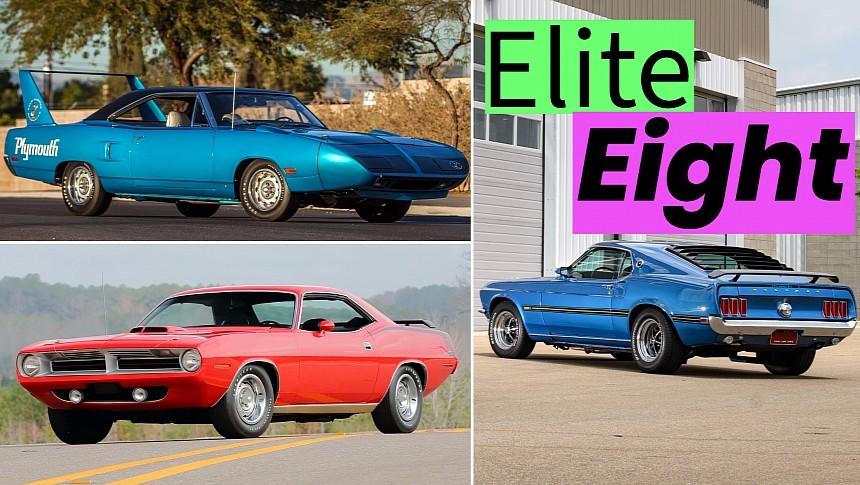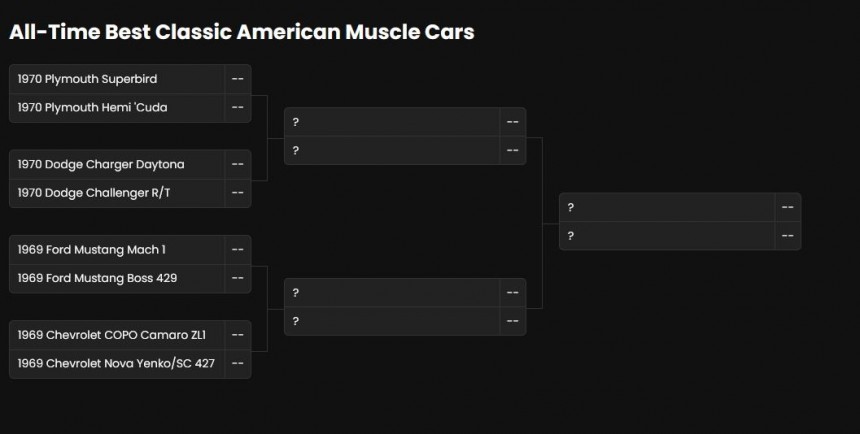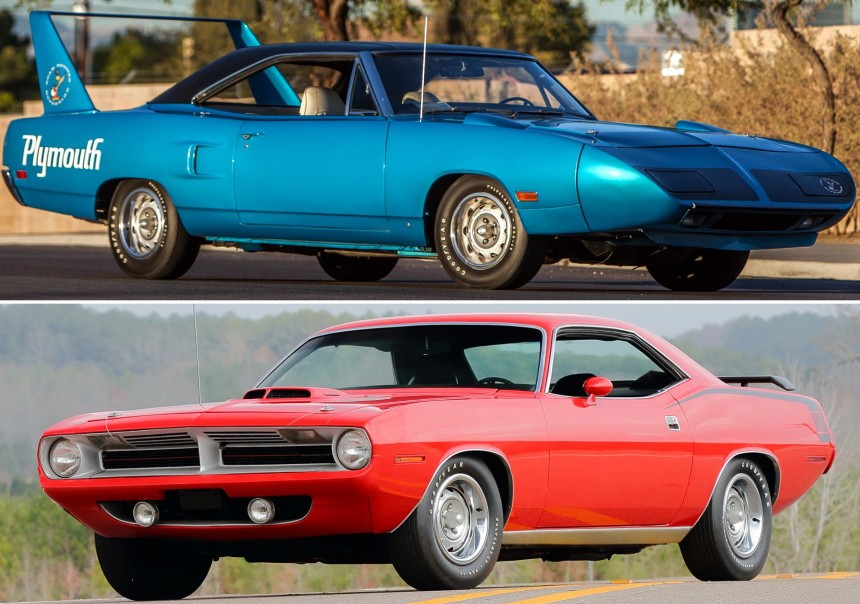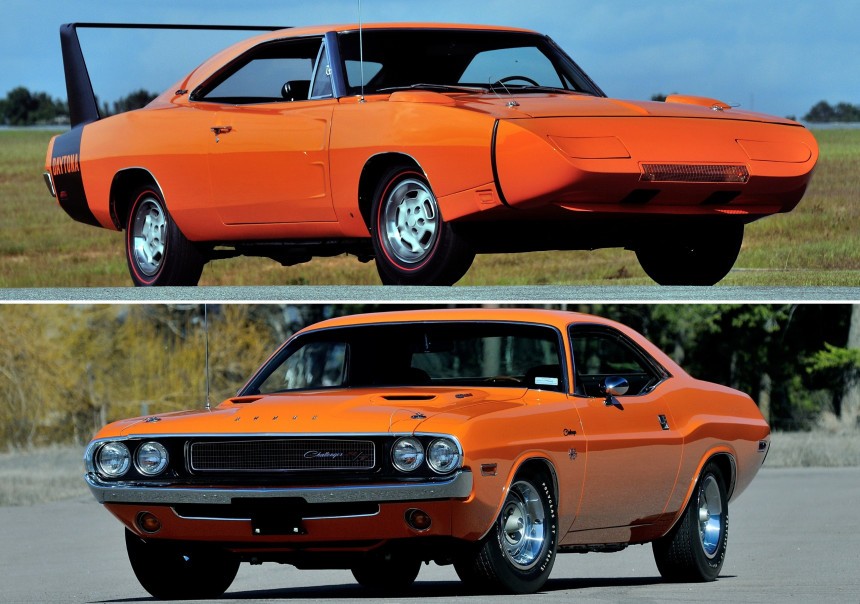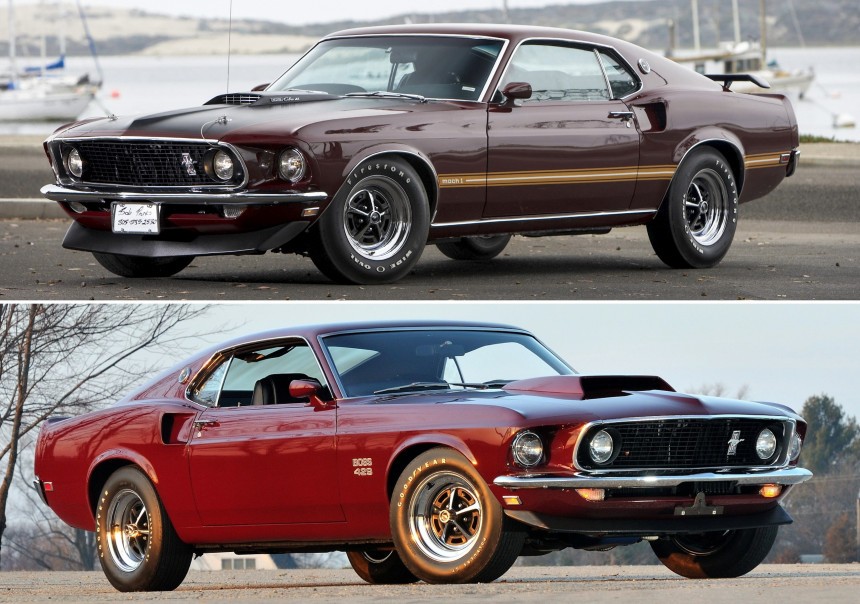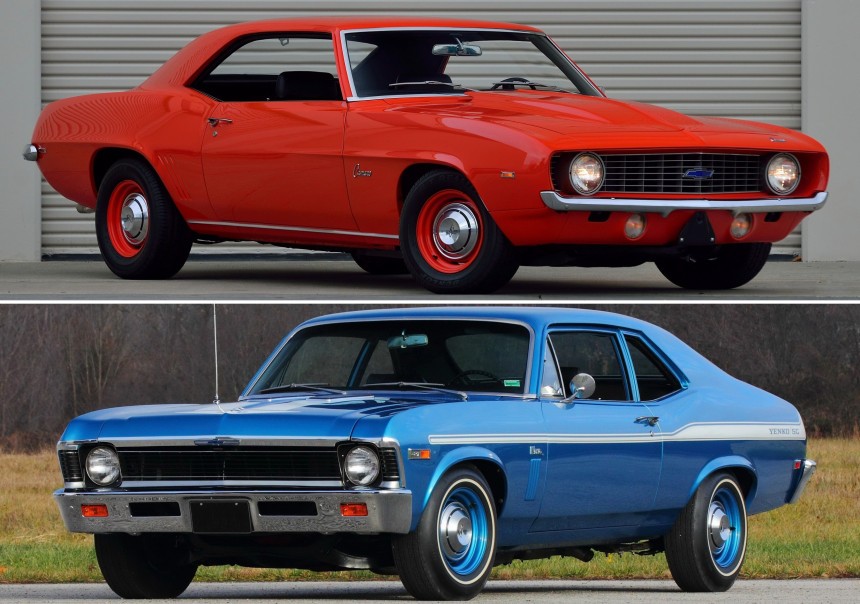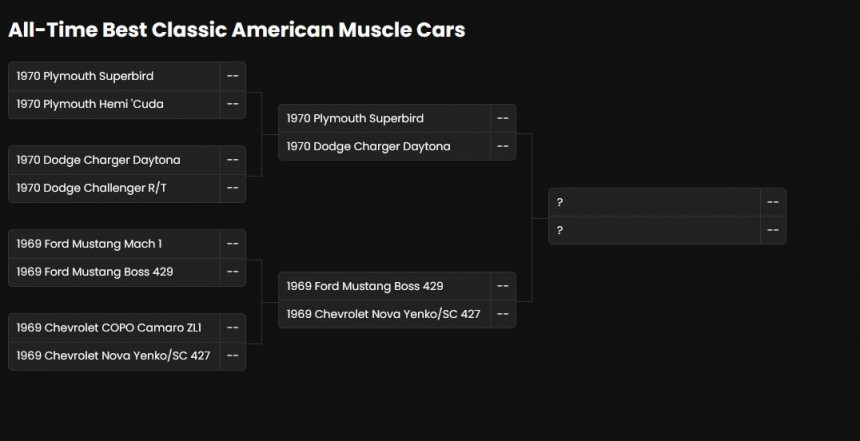I’ll be honest, it’s been somewhat of a whirlwind trying to narrow down our choices for the all-time best classic American muscle cars ever made. It seems that whatever you choose, it’s both right and wrong at the same time. Thankfully, it won’t be long now until we’re left with just two cars to dissect.
The ‘Sweet Sixteen’ round was fun, but we’re in the endgame now, as Dr. Strange once said towards the end of Infinity War. Now, while it’s hard to actually go wrong with any of our choices from this point on, that doesn’t mean we can’t make a clear case in favor of one car over another.
Before we get into that, let’s round up all the classics that didn’t make the cut this week – in no particular order, as always: 1965 Shelby GT350, 1968 Plymouth Road Runner, 1969 Dodge Charger R/T, 1969 Dodge Super Bee, 1970 Ford Mustang Mach 1, 1970 Ford Mustang Boss 429, 1968 Shelby GT500, and the 1970 Chevrolet Chevelle SS 454.
It was difficult to see the Chevelle SS 454 go, just as it was difficult to eliminate the Charger R/T. The other ones though, they didn’t really stand that much of a chance against the competition.
Here’s what we’re dealing with right now
Four incredible matchups, eight legendary muscle cars. A closer look does reveal slimmer odds of advancing for two of the eight cars, but at this point, there are no real losers. Also, it’s Plymouth against Plymouth, Dodge against Dodge, Ford against Ford, and Chevy against Chevy. Believe it or not, I didn’t plan it like this, but it somehow worked out for the best. Each carmaker will produce a semi-finalist.
Ready? Let’s go.
Trying to compare the Plymouth Superbird with the Hemi ‘Cuda is a little like comparing The Sopranos with The Wire. It’s impossible. It’s greatness overload. Both have a valid argument for being the very best TV drama ever made, and the same goes for the Superbird and the Hemi ‘Cuda, with regards to classic muscle cars.
On the surface, the two are very different, especially from a conceptual standpoint. The first-ever Barracuda was designed as a pony car, although the third-gen model that’s relevant to us here did manage to shake off that stigma.
The so-called E-body ‘Cuda was based on the Dodge Challenger, although it didn’t share any sheet metal with its sibling, and it was slightly smaller in terms of length and wheelbase. Compared to something like the Superbird, the ‘Cuda is still the smaller car, and by a considerable margin, which does make it more agile from a driving dynamics standpoint.
Speaking of dynamics, let’s talk Hemi ‘Cuda, with its 426 ci (7.0L) Hemi V8. This specification offered up 425 horsepower and 490 lb-ft of torque, which instantly made you damn near unbeatable on the road.
These cars are incredibly expensive, these E-body Hemi ‘Cudas. You can easily blow hundreds of thousands of dollars on one, maybe even half a million if it’s super-duper nice.
Unlike the Hemi ‘Cuda, the Superbird rides on the carmaker’s B platform, just like the Road Runner on which it is based – and like the Dodge Charger, its closest sibling.
The best way to look at the Superbird is like a NASCAR-inspired, more “looney” version of the Road Runner, pun intended.
Like the Hemi ‘Cuda, the Superbird would also rock the flagship 426 ci Hemi V8 unit, serving up those same 425 horsepower. These two classics would have been evenly matched in a 0-60 mph drag race, although the Superbird is technically quicker to 60 by about 0.2 seconds.
The two main differences here, as far as I'm concerned, are styling and value. The Superbird looks more bonkers than any Barracuda ever could. It really does seem as though you’re driving a stock car for the road. There was nothing else out there as stunning as the Superbird/Daytona duo back in the late 60s and early 70s.
As for value, it will cost you more, on average, to purchase a Superbird. However, the difference isn’t as massive as some people may think. Those Hemi ‘Cudas really are crazy expensive. Still, we have to give the Superbird the edge here too. It’s the more special vehicle of the two.
This was a tough decision to make and believe me that it could have gone either way – up to a point.
Winner: 1970 Plymouth Superbird
After the Charger 500 failed to perform in NASCAR and Richard Petty left Plymouth in favor of Ford, Dodge knew they needed to bring their A-game for the 1969 model year. That’s when they created the Charger Daytona – a limited edition variant of the regular Charger, built specifically for winning NASCAR races.
Compared to something like say, the Charger R/T, the Daytona, also known as a “Wing Warrior”, came with these amazing body mods, like the 23-inch-tall stabilizer wing, the nose cone, flush rear backlight, a window cap, plus new fenders and hood.
The standard engine was the 440 ci Magnum V8, but these could also be had with the 426 ci Hemi V8. If you’re a collector, you’ll definitely want the Hemi, as it was only featured in 70 out of the 503 Daytonas ever made.
In terms of value, there’s really not much of a comparison here. A nice Challenger R/T will set you back a pretty penny, but it’s nothing compared to how much you’ll pay for a Daytona, be it the 440-powered variant or the 426 Hemi. Expect to part with sums in the high six figures, and on some occasions, it’ll cost you over $1 million to reign in one of these babies.
As for arguments that can be made in favor of the Challenger, like I said, you can always grab an awesome spec (Magnum, Six-Pack or Hemi-powered), but it will never reach the heights of the Charger Daytona. Come to think of it, this comparison is pretty much identical to the one from before, between the Superbird and the Hemi ‘Cuda. If the Hemi ‘Cuda couldn’t slay a Superbird, then what chance would a Challenger have against the Daytona? Zero. It loses based on the exact same principles.
Winner: 1970 Dodge Charger Daytona
What a gorgeous matchup this is. The two most beautiful Mustangs ever made, wearing the two most appealing specifications. Both 1969 model year cars, both rocking the aggressive bodywork, and both worthy of a spot in the Sweet Sixteen.
But we’re here to advance somebody to the Final Four, the semi-finals, which means one of these Mustangs is going home and as I live and breathe, I know you know that I know this is actually not a very tough decision at all.
I’ll humor all you Mach 1 fans out there and get into the nitty-gritty, because you can make the case for the Mach 1 being the more attractive spec, from a visual standpoint.
Introduced for the 1969 model year, the Mach 1 stood out thanks to its reflective striping, dual exhaust setup, matte-black hood with either a fake scoop or a real one, plus the NASCAR-style cable and pin tiedowns, rear wing, chin spoiler and louvered back window.
Inside, these came with faux wood trim, high back seats, and additional sound deadening. Such an awesome job by Ford to make these Mustangs really stand out in a crowd of muscle cars. The only “issue” is that when you’re trying to find the best muscle car ever made, you kind of need that top-notch engine option, and the Mach 1 just doesn’t deliver on that front.
These Mustangs were available with a wide range of powertrain options, perhaps too wide. The best you could have done was go for a 428 ci Cobra Jet or Super Cobra Jet V8, which would have landed you 335 horsepower and 440 lb-ft of torque. More than adequate, but not enough for what we’re trying to accomplish here.
Meanwhile, the Boss 429 is a genuine top dog. It’s got the backstory, it’s got the muscle, and it’s a hell of a lot rarer than the Mach 1. These were created only so Ford could homologate the Boss 429 engine for NASCAR use, and no more than 859 units were ever made.
This is a no-contest. Think of the Boss 429, with its 375 horsepower, as the Texas Rangers to the Mach 1’s Arizona Diamondbacks. It’s not a perfect sweep, but more like a gentleman’s sweep.
To be fair though, the Cobra Jet-powered Mach 1 isn’t that much slower than the Boss 429. There’s like half a second between them from zero to 60, which may or may not matter to you.
Winner: 1969 Ford Mustang Boss 429
Unlike having to decide between a Boss 429 and a Mach 1 Mustang, or between a Daytona and a Challenger for that matter, picking a winner between the most special Camaro and Nova variants ever made is borderline impossible.
Neither of these two cars deserves to be ousted. They’re both potential finalists. Fast, rare, and with a solid backstory.
The COPO Camaro was born out of necessity, with GM forbidding Chevy from installing particularly large engines in their compact or mid-size models. Various dealers saw a way around that annoying little memo and went on to use an ordering process that was usually reserved for fleets and special orders.
That’s how the COPO Camaro 9561 was born, with its L72 big-block V8 engine, rated at 425 horsepower and 460 lb-ft of torque. Roughly 200 of these cars were converted by Don Yenko, and ultimately, some 1,000 Camaros would end up receiving the L72 engine option.
The story doesn’t end there though, because drag racer Dick Harrell’s ingenuity is what led to the COPO Camaro 9560 variant, with its all-aluminum 427 ci big-block V8, which was dubbed ZL1.
This car was designed specifically for drag racing, and only 69 units were ever produced. While the engine was rated at 430 horsepower, it wouldn’t have taken much to bump the output to well over 500 horses, making the COPO Camaro ZL1 pretty much unbeatable in a straight line.
Do you know what’s even rarer than a COPO ZL1? The Chevy Nova Yenko/SC 427, of which only 37 units were ever produced. It’s nearly twice as rare as its bowtie brethren, and that’s a significant fact in what we’re trying to achieve here.
Compared to a regular Nova, the so-called Yenko Supernova was redesigned to feature a stronger frame and suspension system in order to handle the heavier and more powerful 427 ci (7.0L) V8 engine with its 425 horsepower and 460 lb-ft of torque.
So then, which of these two cars deserves a spot in the Final Four? Both, obviously. But since that’s not possible, we’re going to have to rank their attributes, and based on how rare this special edition Nova is (plus the fact that only seven units are known to still exist today), I think it wins.
Also, this might be an objective opinion, but I think the third-gen Chevy Nova is actually a more handsome vehicle than the first-gen Chevy Camaro. It looks meaner and more rugged, not to be messed with.
Winner: 1969 Chevrolet Nova Yenko/SC
Next week’s Final Four bracket will feature a blood match between the Plymouth Superbird and the Dodge Charger Daytona, while the insanely rare Chevy Nova Yenko/SC will have to duel it out with the Mustang Boss 429.
Feel free to comment down below regarding which of these four cars is most deserving of a spot in the Final, or the Super Brawl, as I like to call it. Oh, and in case your favorite muscle car didn’t even make the Elite Eight round, you can sound off about that too – any and all rational arguments are more than welcome.
Before we get into that, let’s round up all the classics that didn’t make the cut this week – in no particular order, as always: 1965 Shelby GT350, 1968 Plymouth Road Runner, 1969 Dodge Charger R/T, 1969 Dodge Super Bee, 1970 Ford Mustang Mach 1, 1970 Ford Mustang Boss 429, 1968 Shelby GT500, and the 1970 Chevrolet Chevelle SS 454.
It was difficult to see the Chevelle SS 454 go, just as it was difficult to eliminate the Charger R/T. The other ones though, they didn’t really stand that much of a chance against the competition.
Here’s what we’re dealing with right now
Ready? Let’s go.
1970 Plymouth Superbird vs. 1970 Plymouth Hemi ‘Cuda
On the surface, the two are very different, especially from a conceptual standpoint. The first-ever Barracuda was designed as a pony car, although the third-gen model that’s relevant to us here did manage to shake off that stigma.
The so-called E-body ‘Cuda was based on the Dodge Challenger, although it didn’t share any sheet metal with its sibling, and it was slightly smaller in terms of length and wheelbase. Compared to something like the Superbird, the ‘Cuda is still the smaller car, and by a considerable margin, which does make it more agile from a driving dynamics standpoint.
Speaking of dynamics, let’s talk Hemi ‘Cuda, with its 426 ci (7.0L) Hemi V8. This specification offered up 425 horsepower and 490 lb-ft of torque, which instantly made you damn near unbeatable on the road.
These cars are incredibly expensive, these E-body Hemi ‘Cudas. You can easily blow hundreds of thousands of dollars on one, maybe even half a million if it’s super-duper nice.
Unlike the Hemi ‘Cuda, the Superbird rides on the carmaker’s B platform, just like the Road Runner on which it is based – and like the Dodge Charger, its closest sibling.
The best way to look at the Superbird is like a NASCAR-inspired, more “looney” version of the Road Runner, pun intended.
Like the Hemi ‘Cuda, the Superbird would also rock the flagship 426 ci Hemi V8 unit, serving up those same 425 horsepower. These two classics would have been evenly matched in a 0-60 mph drag race, although the Superbird is technically quicker to 60 by about 0.2 seconds.
The two main differences here, as far as I'm concerned, are styling and value. The Superbird looks more bonkers than any Barracuda ever could. It really does seem as though you’re driving a stock car for the road. There was nothing else out there as stunning as the Superbird/Daytona duo back in the late 60s and early 70s.
As for value, it will cost you more, on average, to purchase a Superbird. However, the difference isn’t as massive as some people may think. Those Hemi ‘Cudas really are crazy expensive. Still, we have to give the Superbird the edge here too. It’s the more special vehicle of the two.
This was a tough decision to make and believe me that it could have gone either way – up to a point.
Winner: 1970 Plymouth Superbird
1970 Dodge Charger Daytona vs. 1970 Dodge Challenger R/T
Compared to something like say, the Charger R/T, the Daytona, also known as a “Wing Warrior”, came with these amazing body mods, like the 23-inch-tall stabilizer wing, the nose cone, flush rear backlight, a window cap, plus new fenders and hood.
The standard engine was the 440 ci Magnum V8, but these could also be had with the 426 ci Hemi V8. If you’re a collector, you’ll definitely want the Hemi, as it was only featured in 70 out of the 503 Daytonas ever made.
In terms of value, there’s really not much of a comparison here. A nice Challenger R/T will set you back a pretty penny, but it’s nothing compared to how much you’ll pay for a Daytona, be it the 440-powered variant or the 426 Hemi. Expect to part with sums in the high six figures, and on some occasions, it’ll cost you over $1 million to reign in one of these babies.
As for arguments that can be made in favor of the Challenger, like I said, you can always grab an awesome spec (Magnum, Six-Pack or Hemi-powered), but it will never reach the heights of the Charger Daytona. Come to think of it, this comparison is pretty much identical to the one from before, between the Superbird and the Hemi ‘Cuda. If the Hemi ‘Cuda couldn’t slay a Superbird, then what chance would a Challenger have against the Daytona? Zero. It loses based on the exact same principles.
Winner: 1970 Dodge Charger Daytona
1969 Ford Mustang Mach 1 vs. 1969 Ford Mustang Boss 429
But we’re here to advance somebody to the Final Four, the semi-finals, which means one of these Mustangs is going home and as I live and breathe, I know you know that I know this is actually not a very tough decision at all.
I’ll humor all you Mach 1 fans out there and get into the nitty-gritty, because you can make the case for the Mach 1 being the more attractive spec, from a visual standpoint.
Introduced for the 1969 model year, the Mach 1 stood out thanks to its reflective striping, dual exhaust setup, matte-black hood with either a fake scoop or a real one, plus the NASCAR-style cable and pin tiedowns, rear wing, chin spoiler and louvered back window.
Inside, these came with faux wood trim, high back seats, and additional sound deadening. Such an awesome job by Ford to make these Mustangs really stand out in a crowd of muscle cars. The only “issue” is that when you’re trying to find the best muscle car ever made, you kind of need that top-notch engine option, and the Mach 1 just doesn’t deliver on that front.
These Mustangs were available with a wide range of powertrain options, perhaps too wide. The best you could have done was go for a 428 ci Cobra Jet or Super Cobra Jet V8, which would have landed you 335 horsepower and 440 lb-ft of torque. More than adequate, but not enough for what we’re trying to accomplish here.
Meanwhile, the Boss 429 is a genuine top dog. It’s got the backstory, it’s got the muscle, and it’s a hell of a lot rarer than the Mach 1. These were created only so Ford could homologate the Boss 429 engine for NASCAR use, and no more than 859 units were ever made.
This is a no-contest. Think of the Boss 429, with its 375 horsepower, as the Texas Rangers to the Mach 1’s Arizona Diamondbacks. It’s not a perfect sweep, but more like a gentleman’s sweep.
To be fair though, the Cobra Jet-powered Mach 1 isn’t that much slower than the Boss 429. There’s like half a second between them from zero to 60, which may or may not matter to you.
Winner: 1969 Ford Mustang Boss 429
1969 Chevrolet COPO Camaro ZL1 vs. 1969 Chevrolet Nova Yenko/SC
Neither of these two cars deserves to be ousted. They’re both potential finalists. Fast, rare, and with a solid backstory.
The COPO Camaro was born out of necessity, with GM forbidding Chevy from installing particularly large engines in their compact or mid-size models. Various dealers saw a way around that annoying little memo and went on to use an ordering process that was usually reserved for fleets and special orders.
That’s how the COPO Camaro 9561 was born, with its L72 big-block V8 engine, rated at 425 horsepower and 460 lb-ft of torque. Roughly 200 of these cars were converted by Don Yenko, and ultimately, some 1,000 Camaros would end up receiving the L72 engine option.
The story doesn’t end there though, because drag racer Dick Harrell’s ingenuity is what led to the COPO Camaro 9560 variant, with its all-aluminum 427 ci big-block V8, which was dubbed ZL1.
This car was designed specifically for drag racing, and only 69 units were ever produced. While the engine was rated at 430 horsepower, it wouldn’t have taken much to bump the output to well over 500 horses, making the COPO Camaro ZL1 pretty much unbeatable in a straight line.
Do you know what’s even rarer than a COPO ZL1? The Chevy Nova Yenko/SC 427, of which only 37 units were ever produced. It’s nearly twice as rare as its bowtie brethren, and that’s a significant fact in what we’re trying to achieve here.
Compared to a regular Nova, the so-called Yenko Supernova was redesigned to feature a stronger frame and suspension system in order to handle the heavier and more powerful 427 ci (7.0L) V8 engine with its 425 horsepower and 460 lb-ft of torque.
So then, which of these two cars deserves a spot in the Final Four? Both, obviously. But since that’s not possible, we’re going to have to rank their attributes, and based on how rare this special edition Nova is (plus the fact that only seven units are known to still exist today), I think it wins.
Also, this might be an objective opinion, but I think the third-gen Chevy Nova is actually a more handsome vehicle than the first-gen Chevy Camaro. It looks meaner and more rugged, not to be messed with.
Winner: 1969 Chevrolet Nova Yenko/SC
Next week’s Final Four bracket will feature a blood match between the Plymouth Superbird and the Dodge Charger Daytona, while the insanely rare Chevy Nova Yenko/SC will have to duel it out with the Mustang Boss 429.
